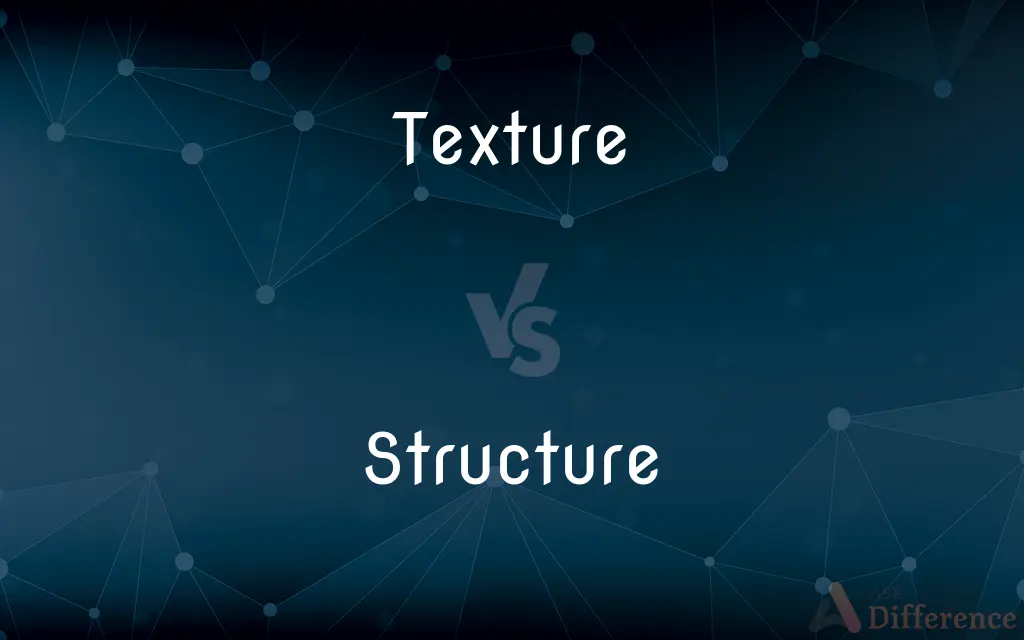Texture vs. Structure — What's the Difference?
By Urooj Arif & Maham Liaqat — Updated on February 27, 2024
Texture refers to the surface quality or feel of an object, determined by its physical characteristics, while structure pertains to the arrangement or organization of parts within a material or system, defining its composition and form.

Difference Between Texture and Structure
Table of Contents
ADVERTISEMENT
Key Differences
Texture and structure, while both related to the physical properties of materials, focus on different aspects. Texture is about the tactile and visual qualities that define the surface of an object. It can be experienced through touch—such as rough, smooth, soft, or hard surfaces—and is also visually perceivable. Structure, on the other hand, dives deeper into the internal organization and framework that determine the material's overall integrity and behavior. It encompasses the way components are connected and arranged, contributing to the material's strength, durability, and functionality.
Textures play a significant role in the aesthetic and functional attributes of materials, influencing perception and usability. For example, the texture of a fabric can affect its comfort and appearance, while the texture of a building material can influence grip and visual appeal. Structural properties are crucial in fields like architecture, engineering, and biology, as they influence how materials perform under various conditions. For instance, the structure of steel provides the strength needed for constructing buildings, while the cellular structure of a plant leaf determines its ability to perform photosynthesis.
Texture might be considered a surface characteristic, structure is more about the core organization. Both are essential for understanding materials' properties, but they serve different purposes, texture influences immediate sensory perception and aesthetic qualities, whereas structure is about underlying support and functional behavior.
Understanding the difference between texture and structure is crucial in various disciplines, including material science, architecture, art, and biology, as it helps in selecting the right materials and methods for specific purposes, ensuring both functionality and aesthetic appeal.
Comparison Chart
Definition
The surface quality or feel of an object.
The arrangement and organization of parts within a system.
ADVERTISEMENT
Focus
Surface characteristics, such as roughness or smoothness.
Internal organization that determines overall form and function.
Importance
Influences sensory perception and aesthetic appeal.
Determines strength, durability, and functionality.
Role in Design
Affects visual and tactile appeal, usability.
Influential in ensuring material performance and integrity.
Example
The softness of a cotton shirt.
The crystalline structure of a diamond.
Compare with Definitions
Texture
Influences visual and tactile perception.
Artists use texture in paintings to add depth and interest.
Structure
The way in which parts are arranged or put together.
The hexagonal structure of honeycombs optimizes space and material use.
Texture
The feel or appearance of a surface.
The smooth texture of silk makes it appealing for clothing.
Structure
Reflects organizational principles.
The structure of a novel organizes the narrative and themes.
Texture
Can be natural or manufactured.
The rough texture of natural stone is often mimicked in concrete products.
Structure
Critical for architectural and engineering designs.
The truss structure provides bridges with both strength and flexibility.
Texture
Varies widely across materials.
Leather textures can range from smooth to heavily grained.
Structure
Can be observed at various scales.
Microscopic structures in metals influence their strength and flexibility.
Texture
Essential for product design and functionality.
The grip texture on tools enhances usability.
Structure
A building or other object constructed from several parts
The station is a magnificent structure and should not be demolished
Texture
The feel, appearance, or consistency of a surface or a substance
The different colours and textures of bark
Skin texture and tone
The cheese is firm in texture
Structure
Determines physical properties.
The porous structure of sponges allows them to absorb water.
Texture
A rough or grainy surface quality
Brick walls give a room texture.
Structure
A structure is an arrangement and organization of interrelated elements in a material object or system, or the object or system so organized. Material structures include man-made objects such as buildings and machines and natural objects such as biological organisms, minerals and chemicals.
Texture
To give texture to, especially to impart desirable surface characteristics to
Texture a printing plate by lining and stippling it.
Structure
The arrangement of and relations between the parts or elements of something complex
The two sentences have equivalent structures
The company's weakness is the inflexibility of its management structure
Texture
The feel or shape of a surface or substance; the smoothness, roughness, softness, etc. of something.
The beans had a grainy, gritty texture in her mouth.
Structure
Construct or arrange according to a plan; give a pattern or organization to
Services must be structured so as to avoid pitfalls
Texture
The feel of a surface or a fabric;
The wall had a smooth texture
Structure
Something made up of a number of parts that are held or put together in a particular way
Hierarchical social structure.
Structure
The way in which parts are arranged or put together to form a whole; makeup
Triangular in structure.
Structure
Something constructed, such as a building.
Structure
The act of building; the practice of erecting buildings; construction.
His son builds on, and never is contentTill the last farthing is in structure spent.
Common Curiosities
Is texture only important in the arts?
While texture is crucial in art for aesthetic reasons, it's also important in design, manufacturing, and usability across various fields.
Can two materials have the same texture but different structures?
Yes, materials can share similar surface textures while having different internal structures, affecting their properties and uses.
Can the structure of a material be changed without altering its texture?
Yes, structural modifications can occur internally (e.g., through heat treatment) without significantly altering the surface texture.
How does the structure contribute to material strength?
The arrangement and bonding of particles within a material can significantly affect its strength, elasticity, and resistance to forces.
How do scientists and engineers analyze structure?
They use techniques like microscopy, spectroscopy, and computational modeling to understand the arrangement and interaction of components within a material.
How does texture affect functionality?
Texture can influence a material's grip, comfort, light reflection, and even air resistance, affecting its usability and performance.
Can the structure of a biological material be mimicked in synthetic materials?
Yes, biomimicry involves replicating the structures of biological materials in synthetic ones to achieve desirable properties.
Why is understanding texture and structure important in material selection?
Knowing the texture and structure helps in choosing materials that meet specific functional and aesthetic requirements for a project.
What role does texture play in consumer products?
Texture affects the perception and desirability of products, influencing choices based on touch, appearance, and user experience.
How is texture considered in environmental design?
Texture is used to influence the environmental interaction with surfaces, affecting aspects like water runoff, heat absorption, and light reflection.
Share Your Discovery

Previous Comparison
Uncontactable vs. Contactable
Next Comparison
Notwithstanding vs. DespiteAuthor Spotlight
Written by
Urooj ArifUrooj is a skilled content writer at Ask Difference, known for her exceptional ability to simplify complex topics into engaging and informative content. With a passion for research and a flair for clear, concise writing, she consistently delivers articles that resonate with our diverse audience.
Co-written by
Maham Liaqat












































